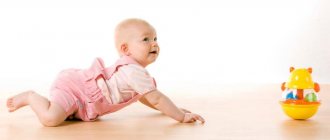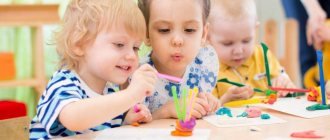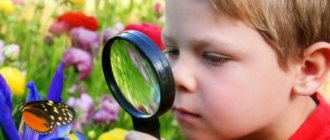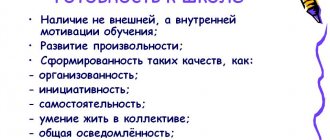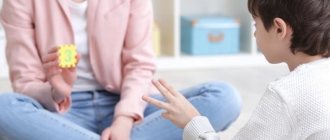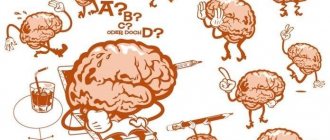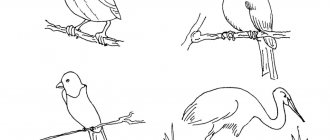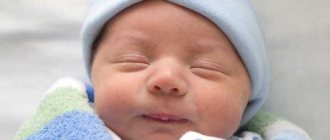Structure and types of leading activities
There are three signs by which a leading activity can be determined:
- leading activity contributes to the emergence of new actions for the child, which he masters over time;
- thanks to it, the formation and restructuring of individual functions of the psyche of a growing person occurs;
- Visible personality changes depend on it.
The mental development of a child is determined by the appropriate type of leading activity. A change in its types means a transition from one stage of development to another, more advanced one.
The stages of human mental development from infancy to senior preschool age are characterized by a certain triune structure of leading activity:
- persisting – moved from the previous stage;
- immediate – characteristic of the current stage;
- nascent - one that is just beginning to develop and will be the leader at the next stage.
Developmental psychology identifies the following types of leading activities at different stages:
- direct emotional communication between the child and the adults around him (from 0 to 1 year);
- object-manipulative (from one to 3 years);
- play (from 3 to 7 years).
For younger schoolchildren (6-11 years old), educational activities are a priority, and for adolescents 11-15 years old, communication is the priority.
Let us take a closer look at the most significant age period for further human development, from 0 to 7 years.
Emotional-volitional sphere
In a psychologically healthy child, internal mental balance and adequacy in behavior predominate, positive relationships with people predominate, a sense of humor and a positive attitude are manifested. The child shows kindness towards people around him and emotional responsiveness. Empathy develops - the ability to empathize.
Children of this age are capable of reflection. They anticipate the reaction of others to their behavior or a certain action and therefore can behave differently with adults.
At 6-7 years old, the child may also experience demonstrative behavior, clowning, and capriciousness. These are symptoms of the crisis of seven years. This age is characterized by emotional instability and rapid mood changes, increased sensitivity. However, parents should not be afraid of this. Such features of the emotional sphere are associated with the activation of the thyroid gland.
The volitional sphere is also developing. Spontaneity in behavior is lost. The ability to restrain your emotional reactions increases. Randomness begins to appear in everything: in behavior, in movements, in the ability to obey rules, in all forms of mental activity. Volitional action reaches its highest levels when the child’s activities are assessed positively by adults and peers. By the age of seven, a child can independently set a goal, draw up an action plan to achieve it, make a decision, and overcome difficulties on the way to achieving the goal.
Leading activity from 0 to 1 year
The beginning of a newborn's life is characterized by the fact that he is completely dependent on the mother or the person replacing her. In the full sense of its significance, the leading type of activity from 0 to 2 months has not yet been determined. Starting from the second period (from 2 to 12 months), for the baby this becomes direct emotional communication with the closest person - the mother. It allows the formation of new formations in the psyche that were not previously inherent in the baby:
- separation of sensations and emotional states;
- involuntary attention (the child is capable of short-term fixation on certain objects);
- the beginnings of visual and effective thinking;
- perception of objects;
- autonomous speech.
The leading activities of infancy form the central, most important new formation that determines the transition to the next stage of development - an ever-increasing need for communication with surrounding adults.
What can your child do?
By the age of 5, the baby already has skills, based on which you can judge the normal development of your child, as well as organize his future activities, educational games and activities.
Consider the general development indicators of older preschoolers.
Speech development
- Builds complex sentences and uses verbs in various tense forms.
- He is interested in the meaning of words, tries to explain the meaning of a word on his own, and can come up with it.
- Rhymes words. Sometimes he distorts a word to make it rhyme (for example, grandfather - handsome grandfather).
- Uses intonation.
- Teaches poems, even large ones.
Social and emotional development
- Partially knows how to control his emotions.
- Can manipulate adults through emotions. He understands that if he cries, they will give him candy. In this case, you should not indulge the child.
- Interested in feelings and emotions: “What is love? Why am I angry? Why is the girl screaming?
- Tries to independently cope with difficulties in communication (for example, if someone offended or took away a toy).
- Uses role-playing games and substitute toys.
- Gender identification becomes more pronounced: “I am a boy. Boys are strong and girls are beautiful!”
- In boys, the role of a protector is manifested (to fight, fight, protect mother), and in girls, the role of a mother is manifested (taking care of toys, playing mother-daughter).
Development of thinking and cognitive skills
- Can count to 10 or 20.
- Knows the names of some letters or shows interest in learning them, can even read syllables.
- State your first and last name, age and address.
- Knows the colors and different shapes of objects.
- Orients itself in space: back, forward, left, right, further, closer, higher, lower.
- Can use gadgets (make phone calls, play cartoons on TV/tablet).
- Becomes more independent in maintaining personal hygiene.
- Able to solve simple logical problems.
- Knows the names of surrounding objects.
- Copies or strives to copy the behavior of an adult of the same sex: “I fish like dad!”, “I paint my lips and comb my hair like mom!”.
Gaming and everyday skills
- Plays with the ball (catch, throw).
- Can jump over obstacles.
- Climbing the horizontal bar ladder.
- Makes the bed.
- Cuts with scissors.
- Strives to depict objects (house, person, sun, car).
- Shows interest in sports, dancing or music.
- Knows that crossing the road or playing on the road is dangerous.
Physical development
- The growth process is activated (in a year a child can grow by 10 cm). Boys' height is on average 106-116 cm, and their weight is from 16 to 20 kg. Girls' height is from 102 to 112 cm, weight is from 15 to 19 kg.
- Coordination of movements improves.
- Motor skills are actively developing, thanks to which the child can already perform more complex actions. It should be noted that the ossification process at this age is not yet complete, so bones easily break when falling.
Leading early childhood activities
In infancy, leading activities formed the psychological properties of the child, which allowed him to move to a higher level of development. Now, object-manipulative actions become decisive, through which children learn about the world around them, filled with many different objects. This whole process takes place under the close attention of adults.
The peculiarity of early age lies in a certain separation of the lines of development of the psyche of boys and girls. For boys, object-tool activities become quite important, and for girls, communicative activities. This occurs due to the specifics of communication with them: cultural patterns of relationships in society orient boys and girls to different types of activities. Therefore, the former have more developed abstract thinking, while the latter have more developed social thinking.
Leading activity at an early age forms the following psychological new formations in children of both sexes:
- self-esteem;
- visual-effective thinking;
- recognition with reproduction;
- development of active speech;
- formation of involuntary attention;
- formation of the self-concept (I am myself).
The child requires more trust and a significant amount of independence.
FORMATION OF PERSONALITY
One of the important aspects in the psychology of preschool age is the process of development of a small personality: its emotions, motivation, self-awareness.
- Emotional sphere.
The period of preschool childhood is relatively stable and calm emotionally: there are practically no special outbursts or conflicts, with the exception of the crisis of 3 years, when the child just realizes himself as a small social person. The stable development of the emotional sphere is facilitated by the development of the child’s ideas. Representations allow him to switch from a specific situation, so the difficulties that arise do not seem so significant. However, the experiences themselves gradually become more complex, deeper, more diverse, and the range of experienced emotions increases. For example, empathy for others appears. The child learns to feel and understand not only his own self. All images in the child’s mind acquire an emotional coloring, all his activities (and this, first of all, play) are saturated with vivid emotions.
- Motivation.
The beginning of personality formation is associated with the formation of such an important personal mechanism as the subordination of motives. They have different significance for a preschooler. One can distinguish motives of self-esteem (competition, achieving success), motives associated with the formation of moral standards, etc. In the preschool years, the child’s individual motivational system begins to build, which will be of great importance for his future success.
- Self-awareness.
It is considered to be the main new formation of the period. The formation of self-awareness is facilitated by active personal and intellectual development. Self-esteem is formed in middle preschool age, initially from one’s own assessment (necessarily positive), and then from assessments of the behavior of others. What is typical: the baby learns to evaluate the actions, skills or behavior of other children first, and then his own.
At this stage, gender identification occurs. Children recognize themselves as representatives of the male or female gender - a girl or a boy, and learn the features of appearance, clothing, character, behavior, and social roles of different sexes. By the senior preschool period, the child begins to perceive himself in time: he remembers what he was like in the past, is aware of himself “here and now,” and can also imagine what he will be like in the future. The baby knows how to correctly express these ideas in speech.
Game is the leading activity in preschool age
At the stage of preschool childhood, development occurs in a situation of learning about human relationships under the influence of an ever-increasing need to imitate them. Therefore, play activity becomes the leading activity for children aged 3-7 years. By the end of the age period, it forms very important new formations in the psyche of a preschooler:
- correct speech;
- involuntary memory;
- analyzing perception;
- visual-figurative thinking;
- creative imagination;
- rudiments of voluntary memory;
- verbal thinking;
- emotional regulation of behavior.
All of them are extremely important for the further development of a full-fledged human personality. Such a large number of neoplasms appear in the process of successive changes in types of gaming activities over 4 years.
Play for a child is a way to express life experiences. In this way, he tries to enter the alluring world of adults, building his model of social relations based on imitation of the existing one. In the process of developing a child’s personality, play goes through several stages of evolution with him.
Subject game
During early childhood, object-based play is important. It is not the leading activity, but is very important for the development of the child. The baby is actively trying to try out familiar objects in new conditions. He is equally enthusiastic about spoon-feeding everyone: his mother, his car, his horse, his doll. And the spoon can be an ordinary popsicle stick. After five minutes, it will become a comb, or a thermometer for the patient. Any jar can turn into a boat or a tea cup. As a result, everyone pretends to drink tea from this cup, where they stir the same imaginary sugar in imaginary water with an imaginary stick-spoon. This is how, through objective play, the little one learns the logic of actions.
The game is plot-display
By the age of three, the child has accumulated enough experience and impressions in understanding the surrounding material world, as well as the world of human relationships. The leading activity in preschool age at this stage is plot-display play. The child plays independently with the toys he has. They are transformed into the main characters of the play invented by the little director.
Habitual dolls become mothers or children, doctors or patients. The child is still unable to distinguish the relationship between them: it is not the toy mother who feeds her son, but the baby puppeteer himself who does this for both of them. But the toddler already clearly indicates the peculiarities of human behavior in reality: his toys are capricious, angry, asking for forgiveness. That is, the game now has a plot and reflects the relationships between people.
How often do moms and dads have the opportunity to recognize themselves by looking at the behavior of a doll controlled by their daughter or son!
Role-playing game
For the older preschooler, the time has come for the most difficult type of leading activity in childhood - role-playing play. Its peculiarity and at the same time complexity: several children already become participants. They not only represent relationships in the game's plot, but also learn them in reality. It happens that a conflict arises from a game, so the children have to learn to distribute and change roles, help each other, share, and prove that they are right. At this stage, leading activities in preschool age shape a person’s business qualities, because one must be able to come to an agreement with others, give in or insist on one’s own.
The borderline age of preschool childhood is approaching ever closer, role-playing games are becoming more and more abstracted from the environment: children, using their imagination, go into space, save people on a desert island, put out fires, etc. They have to establish stricter rules, requiring detailed and precise implementation.
Constantly becoming more complex types of play require the presence and attention of adults who will have to supervise it. No, mentoring instructions should not be given out under any circumstances.
The main role of the father, mother, and educator is to provide food for the imagination of children.
Activities to help your baby
To help your child develop, you can include various games and exercises in his activities that will contribute to the formation of certain skills and abilities. Be sure to introduce outdoor games, combining them with educational ones. Remember that the baby is not yet ready to obediently sit at his desk and fulfill all your demands.
It is worth considering the following examples of games - most older preschoolers like them.
- "Basket".
Goal: develop thinking and expand vocabulary.
You tell your child that you are going outdoors and you need to collect a basket of necessary things. You can start listing them: water, sandwiches..., and the baby should continue. Use different variations of the game: pack a suitcase for a trip, a bag for a walk, a basket in a store, etc.
- "Smart Ball"
Goal: to develop logic, thinking, attention, coordination, memory.
To play you will need a ball. It is advisable for several people to participate. Choose a topic and name it - for example, transport. The presenter throws the ball, and the participants catch and name any vehicle known to them. Of course, this cannot be repeated. When your child or children begin to make frequent mistakes, switch to a different topic.
- “What’s superfluous here?”
Goal: development of abstract logical thinking.
It is necessary to offer the child several groups of objects (start with one, you can use pictures for this). These could be vegetables or fruits, dishes or toys - the main thing is that one item is superfluous. The child must understand which one. This is a rather difficult game for kids, so give some hints: “How can all these objects be called in one word?”
- “Who will the eagle catch?”
Goal: to develop attention and motor activity.
Several people must participate. At first there may be one eagle who will catch bunnies. Whoever gets caught becomes the next eagle. Then you can complicate the game by making several eagles and several bunnies.
- "Charades".
Goal: to develop imagination, logical and figurative thinking.
Usually animals are depicted in charades, but you can try showing objects. You can use pictures that you put in the hat. Children will take turns pulling out and showing the depicted object, and the rest must guess who it is.
- “Assemble our house.”
Goal: development of fine motor skills, imagination, assistance in forming an image of the family and oneself.
On A3 sheet or Whatman paper you will need to assemble an applique of the house in which the baby lives, maybe his room. Place family members there, including himself.
To do this, you will need either paints or images of various objects that can be cut out (sofa, bed, toy box, etc.), as well as your family photographs or their printout on A4 sheet, scissors or brushes. Let the child cut out all the necessary items and photos of family members. Next you will need to distribute them on whatman paper. For example, mom may be in the kitchen, dad in the office, the child is playing with toys, etc.
- "What changed?"
Goal: development, memory, attention, thinking, imagination, logic.
To do this, you will need two similar pictures, but one should contain some objects and details that are missing on the other. Show your child the first picture and ask him to remember what it shows. Then put it away and ask them to talk about this image. Ask leading questions that will help your child describe the picture. After that, show him the second one and ask him what’s new on it that wasn’t on the first one?
If your child finds it difficult to do this exercise at first, show both images at once and simply ask them to tell you how they differ.
- “Unite.”
Goal: development of thinking and logic.
You will need items of different colors and shapes. It is necessary to give the child the task of combining all the objects, for example, pink ones into one group, and white ones into another. The same with the shape: square to the right, triangular to the left. Then you can make it more complicated and ask them to put the triangular ones in a white box and the pink ones in a square one.
